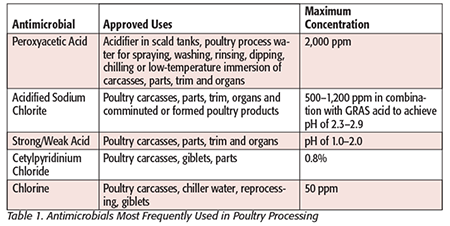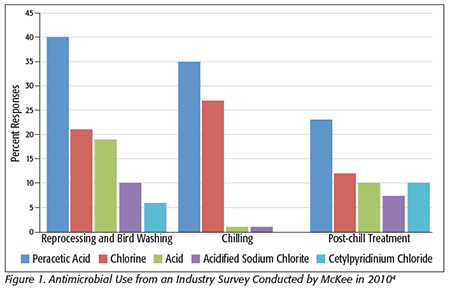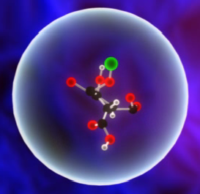Processing aids are used in the production of many foods including poultry. Antimicrobials are a processing aid used to reduce foodborne pathogen contamination, thereby enhancing product food safety. The specific parameters for antimicrobial use in the production of poultry products are described in the U.S. Department of Agriculture Food Safety and Inspection Service (USDA-FSIS) Directive 7120.1 Rev. 43 (October 5, 2017).
Antimicrobials can be used during multiple steps of poultry processing to create a multi-hurdle approach to minimizing contamination. These steps include prescald brushing, scalding, defeathering, evisceration, on- and off-line reprocessing, carcass washing at multiple steps in the process, chilling and post-chill treatment. While some efficacy has been demonstrated, antimicrobials are generally not applied in the initial steps from slaughter, scalding and defeathering due to added costs and low overall benefit. Most processing plants apply antimicrobials during equipment spraying, carcass washing, reprocessing, immersion chilling and post-chill treatment. To determine efficacy of antimicrobials during each step of the process and to ensure process controls, processing plant biomapping should be conducted regularly. Developing plant biomaps can alert plant managers to any potential process issues and help processors decide which antimicrobials are most effective and at which sites in the process they have the greatest benefit.
A Closer Look at the Process
Following the birds’ arrival at the processing plant and slaughter, an optional brush wash cabinet may be used to remove organic material in combination with a chlorinated water spray. Removing organic material at this stage can help reduce the amount of fecal material entering the scald tank. Feathered carcasses are then scalded in hot water to aid in feather removal. Antimicrobial treatments can be added to scald water, but this poses several challenges. High water temperatures can lead to off-gassing of antimicrobials, and the high organic load may bind and deactivate antimicrobials. The use of sulfuric acid, ammonium sulfate and copper sulfate in scald water has been suggested to decrease aerobic plate counts and Escherichia coli and Salmonella prevalence, as well as minimize cross-contamination.[1] The use of countercurrent water flow between multiple-stage scald tanks can help minimize organic loading and potential cross-contamination in scald tank water.
Microbial contamination has been demonstrated to increase during defeathering.[2,3] When the carcasses enter the picker, rows of disks with spinning rubber picker fingers are used to remove feathers. During this process, the carcasses are massaged and compressed, which has a negative side effect of expressing fecal contents from the lower digestive tract. Steps to minimize contamination include maintenance of picker fingers and adequate feed withdrawal. Generally, antimicrobials are not applied during defeathering due to the large volumes of water being used. However, an antimicrobial rinse following defeathering can decrease contamination. Technologies to prevent expression of fecal contents or the application of antimicrobials during defeathering may be useful in minimizing such cross-contamination. Development of systems for antimicrobial application could provide an additional hurdle against pathogen contamination.
 The majority of antimicrobial controls are applied following defeathering. A multi-hurdle approach is used by applying multiple antimicrobial interventions. These antimicrobials are applied during pre-evisceration carcass wash, equipment spraying during venting, opening, evisceration, cropping, inside-outside carcass washing post-evisceration, on-line and off-line reprocessing, prechill dip treatment, carcass chilling, post-chill carcass treatment and parts washing (Table 1).
The majority of antimicrobial controls are applied following defeathering. A multi-hurdle approach is used by applying multiple antimicrobial interventions. These antimicrobials are applied during pre-evisceration carcass wash, equipment spraying during venting, opening, evisceration, cropping, inside-outside carcass washing post-evisceration, on-line and off-line reprocessing, prechill dip treatment, carcass chilling, post-chill carcass treatment and parts washing (Table 1).
Commonly Used Antimicrobials in Poultry Processing
The most commonly used antimicrobials are peracetic acid (PAA), cetylpyridinium chloride (CPC), acidified sodium chlorite (ASC), organic acids, bromine and chlorine (Figure 1[4]). Each of these antimicrobials has advantages and disadvantages.
 PAA is a mixture of acetic acid and hydrogen peroxide. Application concentration depends on the length of application time. PAA is applied at higher concentrations (200–300 ppm) during short-term treatments (< 1 minute) such as reprocessing, pre- and post-chill carcass treatments and broiler parts treatments. Lower concentrations (20–50 ppm) are used during longer-term (60–120 minutes) immersion carcass chilling. PAA is approved for use up to 2,000 ppm; however, such high concentrations can impact the visual appearance of the carcass, can be unpleasant for plant employees and may have detrimental microbial kill-off impact during plant wastewater treatment. PAA has been demonstrated to be very effective, can be used on products labeled “organic” and is approved for use on exported products.[5] In a 2010 industry survey, PAA was the most frequently used antimicrobial for on-line reprocessing, inside-outside bird washers, carcass chilling and post-chill treatment.4 Disadvantages include high cost, potential yield losses following long-term exposure, increased fat in wastewater and potential product “graying” from chemical reaction with heme in blood.
PAA is a mixture of acetic acid and hydrogen peroxide. Application concentration depends on the length of application time. PAA is applied at higher concentrations (200–300 ppm) during short-term treatments (< 1 minute) such as reprocessing, pre- and post-chill carcass treatments and broiler parts treatments. Lower concentrations (20–50 ppm) are used during longer-term (60–120 minutes) immersion carcass chilling. PAA is approved for use up to 2,000 ppm; however, such high concentrations can impact the visual appearance of the carcass, can be unpleasant for plant employees and may have detrimental microbial kill-off impact during plant wastewater treatment. PAA has been demonstrated to be very effective, can be used on products labeled “organic” and is approved for use on exported products.[5] In a 2010 industry survey, PAA was the most frequently used antimicrobial for on-line reprocessing, inside-outside bird washers, carcass chilling and post-chill treatment.4 Disadvantages include high cost, potential yield losses following long-term exposure, increased fat in wastewater and potential product “graying” from chemical reaction with heme in blood.
CPC is typically used as a post-chill treatment with a maximum concentration of 0.8%. CPC has been shown to be effective against Salmonella after short-term treatment. However, USDA-FSIS specifies that carcasses/parts treated with CPC must be rinsed following treatment with potable water. CPC in wastewater may also have detrimental microbial kill-off during wastewater treatment.
ASC is applied as a dip during chilling or during pre- or post-chilling treatments. Chilling levels are generally low (50–150 ppm), while short-term dip treatments can be applied at higher concentrations (1,200 ppm). ASC has been shown to be effective, particularly as a short-term dip treatment, but antimicrobial mixing systems can be expensive.
Acid mixtures can be applied in process water, reprocessing, chilling and as a post-chill treatment. This type of antimicrobial works by decreasing the water pH to 1.0–2.0 and is low cost and effective. However, they require a longer contact time, and there may be some issues with equipment corrosion.
Chlorine (20–50 ppm) is often used for cleaning of equipment to minimize carcass cross-contamination. It is also applied to carcasses during washing. In the past, chlorine was frequently used during immersion chilling, but it is not unusual to see chlorine used in commercial chillers. It is inexpensive as well as very effective when used under certain conditions. However, inactivation due to organic loading and the need to maintain pH below 6.5 make chlorine a less advantageous antimicrobial. Additionally, its use can impact the ability to export products. While chlorine can be used in the U.S., it is not allowed as a processing aid in the European Union.
Regardless of which antimicrobial is used, several additional factors should be considered. Employee safety should be a top priority. These antimicrobials are often applied in an enclosed environment, such as a wash cabinet, but are sometimes applied in a more open environment, such as the chill tanks. Employees should always wear the proper personal protective equipment and have regular training on the use and hazards of the antimicrobials being used. To help ensure safety, airflow should be regulated and monitored, and it is beneficial to have antimicrobials diluted mechanically to avoid contact with the concentrated chemical.
Dianna V. Bourassa, Ph.D., is an Assistant Professor/Extension Specialist of Poultry Processing in the Department of Poultry Science at Auburn University.
References
1. Russell, SM. 2011. “Intervention Strategies for Reducing Salmonella Prevalence on Ready-to-Cook Chicken.” Proceeding of the 22nd Latin American Poultry Congress.
2. Berrang, ME et al. 2001. “Broiler Carcass Contamination with Campylobacter from Feces during Defeathering.” J Food Prot 64:2063–2066.
3. Clouser, CS et al. 1995. “Effect of Type of Defeathering System on Salmonella Cross Contamination during Commercial Processing.” Poult Sci 74:732–741.
4. McKee, SR. 2011. “Salmonella and Campylobacter Control during Poultry Processing.” Presented at the 2011 International Poultry Exposition, Atlanta, GA, January 24–25, 2011.
5. Wideman, N et al. 2016. “Evaluating Best Practices for Campylobacter and Salmonella Reduction in Poultry Processing Plants.” Poult Sci 95:306–315.
Antimicrobial Use in Poultry Processing




